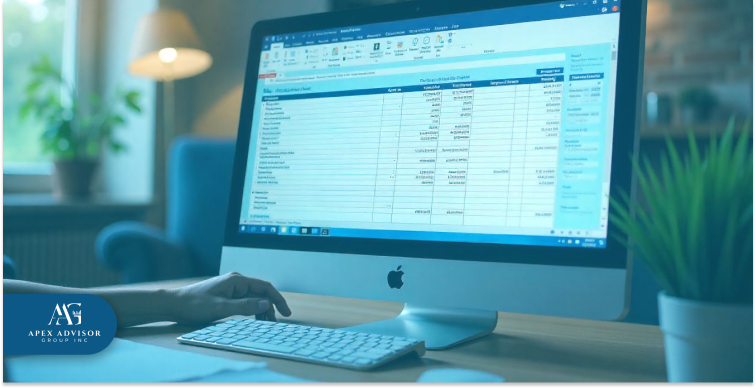How to Prepare Financial Statements Step-by-Step?

April 10, 2025
What if financial statements could tell a complete story—not just numbers on a page, a clear record of a business’s financial position? Every transaction, expense, and source of income plays a role in shaping that story. Without a structure, financial data can become unclear and unreliable.
Accurate financial statements ensure compliance, decision-making, and transparency, as each step aligns records with legal standards. A structured approach helps maintain accuracy, prevent errors, and provide a clear view of financial health.
Step 1: Gather Essential Financial Records Before You Start
Before you begin preparing financial statements, it's important to collect all necessary financial records.
(1) Important Documents to Collect
Bank Statements: These track all incoming and outgoing transactions, offering a comprehensive view of your business's cash flow. Reviewing them helps ensure that all financial activity is accounted for.
Invoices and Receipts: These serve as proof of business transactions, verifying both income and expenses. Keeping these organized allows for easier tracking and reconciliation of sales and purchases.
Payroll Records: If you have employees, payroll records ensure salaries, wages, benefits, and tax withholdings are correctly documented.
Tax Documents: These include previous tax filings, tax payment records, and any deductions claimed. Having these on hand helps maintain compliance with tax obligations and prepares you for tax season.
(2) Loan Agreements and Debt Records
If your business has any outstanding loans or financial liabilities, these agreements must be recorded to maintain transparency in financial reporting. Ensuring the accuracy of these records minimizes errors and discrepancies, providing a solid foundation for financial reporting. Proper documentation also helps in compliance with regulatory requirements, facilitates audits, and enhances credibility with investors and stakeholders.
Keeping detailed records of loan terms, repayment schedules, interest rates, and collateral obligations ensures better financial planning and risk management. Additionally, maintaining updated financial records enables businesses to assess their financial health, make informed strategic decisions, and avoid potential legal or financial complications.
Step 2: Record All Business Transactions Correctly

Accurate record-keeping is important for preparing financial statements. Every financial transaction should be properly categorized and documented to maintain clarity and consistency. This can be done using accounting software or a manual ledger.
(1) Categories of Transactions
Revenue: This includes all income earned through sales, services, investments, or other business activities.
Expenses: Operating costs such as rent, utilities, salaries, supplies, marketing, and maintenance expenses.
Assets: Items of value that your business owns, including cash, inventory, real estate, machinery, and equipment.
Liabilities: Financial obligations such as loans, accounts payable, and credit card debt.
Equity: Owner investments, retained earnings, and any distributions made to shareholders.
Recording transactions under the correct category ensures consistency and clarity in financial reports. Errors in this stage can lead to inaccurate statements and misinformed decision-making.
Step 3: Adjust Journal Entries for Accurate Reporting
Adjustments are necessary to reflect the true financial position of your business. Certain transactions might not be recorded immediately, requiring adjusting entries to ensure financial statements provide an accurate snapshot of the company’s financial health.
(1) Common Adjustments
Accrued Expenses & Revenue: Income and expenses should be recorded in the period they occur rather than when cash changes hands. For example, if a service was provided in December and paid for in January, it should be recorded in December’s financial statements.
Depreciation & Amortization: Assets lose value over time. Adjustments for depreciation (tangible assets like equipment) and amortization (intangible assets like patents) help reflect their decreasing value.
Prepaid Expenses & Outstanding Liabilities: If a business pays for expenses in advance, these must be recorded properly. Similarly, any outstanding liabilities, such as unpaid bills, should be documented to avoid misstatements.
Making these adjustments guarantees that financial statements provide a true and fair view of the company’s financial standing.
Step 4: Create an Accurate Income Statement
The Income Statement provides insight into the profitability of a business by outlining revenues, expenses, and net income over a specific period.
(1) Steps to Prepare an Income Statement
Calculate Total Revenue: Sum up earnings from all sources, including sales, service income, and other revenue streams.
Deduct Cost of Goods Sold (COGS): Identify direct costs associated with producing goods or services.
Subtract Operating Expenses: Account for rent, salaries, utilities, marketing, and other operational costs.
Account for Taxes and Interest: Deduct these from the remaining balance.
Determine Net Income: The final profit or loss after all expenses.
(2) Example format
Total Revenue: $100,000
COGS: $40,000
Gross Profit: $60,000
Operating Expenses: $30,000
Operating Income: $30,000
Taxes & Interest: $5,000
Net Income: $25,000
This structure helps visualize the company’s financial performance.
Step 5: Prepare a Balanced Balance Sheet

A Balance Sheet is a financial statement that provides a snapshot of a company's financial position at a specific point in time. It follows the fundamental accounting equation:
Assets=Liabilities+Equity
Main Components of a Balance Sheet:
Assets: What the company owns, including cash, accounts receivable, inventory, and property.
Liabilities: What the company owes, such as loans, accounts payable, and other obligations.
Equity: The owner's or shareholders' stake in the company, including retained earnings and capital investments.
A balance sheet helps businesses assess financial health, liquidity, and overall stability. It is commonly prepared at the end of an accounting period, such as quarterly or annually.
(1) Categories to Include
Current Assets: Cash, accounts receivable, and inventory.
Non-Current Assets: Machinery, real estate, and long-term investments.
Current Liabilities: Short-term loans, accounts payable, and accrued expenses.
Long-Term Liabilities: Mortgages and long-term business loans.
Owner’s Equity: Retained earnings and capital contributions.
Ensuring that total assets match total liabilities and equity verifies the accuracy of financial statements.
Step 6: Track Your Business Liquidity with a Cash Flow Statement
A Cash Flow Statement is like a financial pulse check for your business. It shows how much money is coming in, where it’s going, and whether you have enough to keep things running. Many businesses struggle not because they aren’t making a profit—because they don’t have enough cash on hand. This statement helps you avoid that situation.
(1) Why a Cash Flow Statement Matters
Cash flow is what keeps your business alive. Your sales numbers might look great. If you don’t have enough cash to cover expenses, your business could be at risk. This could lead to missed payroll, unpaid bills, or even shutting down operations.
A Cash Flow Statement helps you:
✓See if you have enough cash to handle expenses.
✓Spot potential cash shortages before they become a crisis.
✓Make smarter financial decisions about spending, investing, or borrowing
✓Breaking Down the Cash Flow Statement
A Cash Flow Statement is divided into three main sections:
Operating Activities: This is your day-to-day cash flow. It includes money coming in from customers and going out for things like rent, payroll, and utility bills.
Investing Activities: This covers cash spent or received from buying or selling assets, like new equipment or property.
Financing Activities: This tracks cash from loans, repayments, investor contributions, and dividend payments.
(2) How to Prepare a Cash Flow Statement
Businesses can calculate cash flow in two ways:
Direct Method: Lists actual cash transactions, like money received from customers and payments made to suppliers.
Indirect Method: Starts with net income and adjusts for non-cash expenses, such as depreciation or outstanding invoices.
(3) Example of a Cash Flow Statement
Imagine your business has the following cash movements in a month:
Cash from operating activities: $15,000 from sales and services.
Cash from investing activities: You spent $10,000 on new equipment.
Cash from financing activities: You received a $5,000 loan.
At the end of the month, your net cash flow is $10,000. This means your business has enough cash to cover expenses and plan for growth.
(4) Why This Matters for Your Business
Many businesses fail because they don’t manage their cash properly. A positive cash flow means you can pay your bills on time, invest in growth, and avoid financial stress. On the other hand, if your cash flow is negative, it’s a sign that you need to adjust your spending, increase revenue, or find additional funding.
Find out more legal solutions here:
Step 7: Review and Verify Financial Statements for Accuracy

Once the financial statements are prepared, they must be thoroughly reviewed to ensure accuracy, consistency, and compliance with accounting standards. A careful review can prevent financial misstatements, legal risks, and potential issues with regulatory authorities.
(1) Important Steps in the Review Process:
✔ Cross-check figures for Consistency
Compare numbers across all financial reports (income statement, balance sheet, and cash flow statement) to ensure they align.
Verify that revenue, expenses, and net income match across related reports.
✔ Identify and Correct Errors
Look for discrepancies in recorded transactions, missing entries, or misclassifications.
Recalculate key figures, such as total revenue, net income, and retained earnings, to confirm accuracy.
Ensure all adjusting journal entries (such as depreciation, accruals, and deferrals) have been properly recorded.
✔ Ensure Compliance with GAAP or IFRS
Confirm that all financial statements follow Generally Accepted Accounting Principles (GAAP) or International Financial Reporting Standards (IFRS), as required. Follow the Financial Accounting Standards Board (FASB) Accounting Standards to ensure your statements comply with GAAP.
Check disclosures and footnotes for completeness and transparency, ensuring they accurately explain financial data and any potential liabilities.
Review accounting policies applied to transactions, making sure they align with industry standards and legal requirements.
Apex Advisor Group: Your Trusted Partner in Financial Statement Preparation
Managing financial statements takes time and attention. However, we’re here to help.
Clear and Accurate Reports
We make sure your financial statements are organized, reliable, and meet all accounting standards.
Catching Mistakes Early
We go through your records carefully to spot and fix any errors before they cause trouble.
Solutions That Fit Your Business
Whether you’re running a small shop or a growing company, we adjust our approach to match what you need.
Staying Prepared for Taxes and Audits
We keep your financial records organized, so when tax season or audits come around, you don’t have to stress.
Practical Guidance
We explain your financials in a way that actually makes sense, so you know exactly where your business stands and what to do next.
